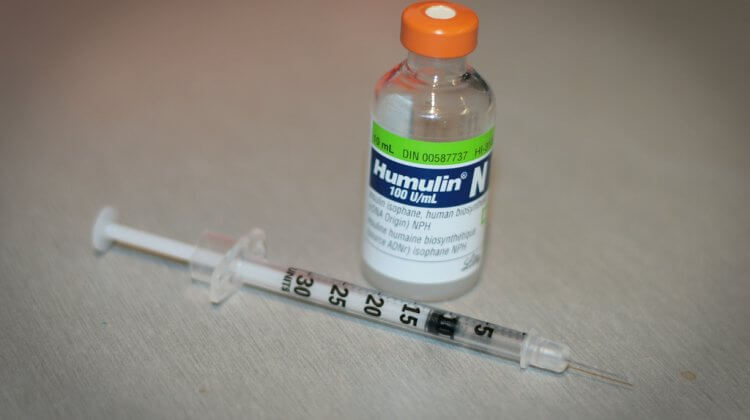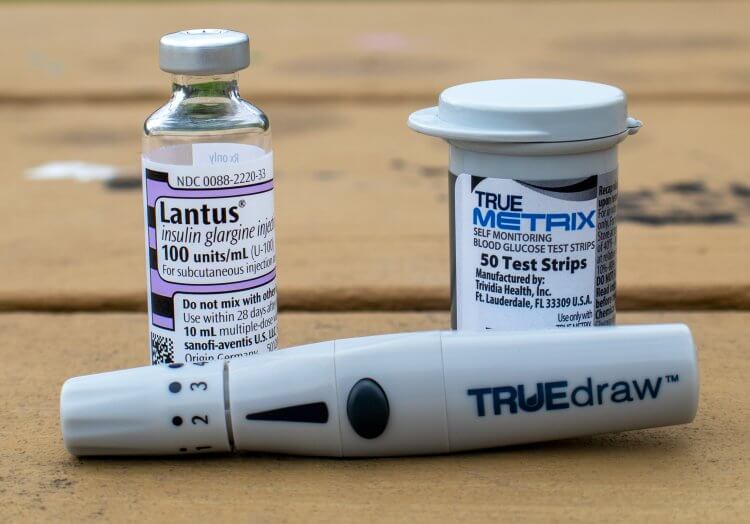
Thanks to guys like Dr. Atkins and “Zone” author Barry Sears, everyone now knows that insulin makes you fat. Just eating in a way that causes excessively high insulin levels can pack on the pounds faster than a bodybuilder can suck down a pizza after the night show. The thing is, insulin is also the most anabolic hormone there is, period.
Sure, you say, GH packs on muscle. So do many steroids. Both true. But the really massive guys on the pro circuit will tell you the truth if you can ever get their confidence. None of them have ever gotten really, truly massive without adding insulin to their stacks. They’ll also tell you, however, that nothing else made them as FAT as using insulin. This is because insulin drives protein and carbohydrate into muscle but insulin also shunts tons of fat into adipose tissue storage if you give it the chance.
One night, Mike Zumpano and Dan Duchaine and I were sitting around having one of our philosophical discussions on the various idiosyncrasies of various anabolic pharmaceuticals. For some reason the talk turned to insulin. Horrified at the idea of having any fat on my body whatsoever (okay, maybe I’m small but I’m LEAN), I immediately said, no way! That stuff makes you FAT!
Mike was more philosophical. He suggested that the ideal way to use insulin would be to set up a bilateral IV drip of straight parenteral amino acids (DO NOT TRY THIS AT HOME!!!!!) and after it had been running into your veins for a while, take a lethal injection of insulin…This, Mike said would get you huge. Dan suggested that if he were doing this, he’d give the guy the injection in a freckle so it wouldn’t show in case he died!
While I concurred that such might be the ideal strategy, I was hard pressed to agree that the risks were in alignment with the potential benefits. I tried to get the conversation to turn towards a less ludicrous topic. “Mike, I said, why does insulin make these guys so fat?
His response was that it wasn’t insulin, it was fear. This made zero sense to me, so I pressed him on it. He explained that most of the fat gain is caused by excess carbohydrate consumption during insulin use. The common dictum is that to use insulin safely, one must concurrently consume a minimum of 10 grams of carbohydrate for each IU of insulin used. Thus, for a bodybuilder using 8 IU’s of insulin 2 times a day, in addition to his normal intake of fat and protein and carbs, he would need to consume a minimum of 160 grams of extra carbohydrate to keep him from going into a hypoglycemic coma. You’d hardly expect that 160 extra grams of carbs, or 640 extra calories per day would make a significant difference to someone already eating 5000 or more calories per day. In most cases it wouldn’t, but that’s not what Mike felt was happening in the real world.
The thing is, most bodybuilders have a high degree of fear about going into insulin shock. So they have a tendency to be somewhat reactive to any change in mental state following an injection. This leads to a much more substantial intake of carbs than simply the 10 grams per IU.
Though this amount of additional carbohydrate does not seem terribly excessive, I was certain that it was the primary reason why insulin users gained a lot of size but also a disproportionate amount of fat. In discussing this with Mike Zumpano, several things occurred to us. First, what was the rationale behind this dosage of carbohydrate? Second, did consuming this amount of carbohydrate have a basis in human biochemistry? And third, was there a more elegant solution that would enable bodybuilders to use insulin safely for anabolic effect but avoid the excessive fat gains that have so far plagued users?
We both felt that there had to be a better way. Human plasma only contains about 5 grams of carbohydrate at any one time. Diabetics that have taken too much insulin can usually get their blood sugar levels back into normal range by consuming as little a five grams (only 20 calories!) of dextrose. IF that was the case, then how did we arrive at the 10-gram per IU rule?
A New and Dangerous Method for “No Fat Gain” Insulin Use
Okay, so maybe it’s not terribly dangerous (provided you do it exactly like I say here), but it takes a hell of a lot of discipline to do it this way. The pay-off is a big muscle gain with a minimal fat gain. Is it worth it? You be the judge.
Here’s the trick; take your insulin, but only follow a LOW CARB DIET. That’s right, LOW. As in less then 50 grams of carbs per day low! Insanity? Let me explain the biochemical rationale and you can decide for yourself.
Here’s the theory. If you aren’t interested in anything except being huge, you can skip this and go right to the meat of the program. But before you do, MAKE SURE YOU READ THE WARNINGS! DO NOT ATTEMPT TO TRY THIS PROTOCOL. THIS PROGRAM CAN BE VERY DANGEROUS! DON’T MONKEY AROUND WITH THIS. ALSO PLEASE NOTE THAT THE AUTHOR AND THE PUBLISHERS WILL NOT BE HELD LIABLE FOR ANY DEATHS OR INJURIES ASSOCIATED WITH THIS THEORETICAL APPROACH TO USING INSULIIN FOR MUSCLE GAIN!!! SIMPLY STATED, IF YOU TRY THIS THEORETICAL APPROACH TO INSULIN USE, YOU UNDERSTAND THAT YOU MAY SERIOUSLY HARM YOURSELF OR DIE, THUS FORFEITING YOUR RIGHTS TO HOLD ANYONE RESPONSIBLE BUT YOURSELF!
When I became convinced that insulin was preferentially repartitioning carbs into adipose tissue storage, I asked myself if there was some other way to maintain moderate blood sugar with a high degree of stability. My answer was gluconeogenesis. If you look on a biochemical pathways chart (Boehinger’s is my personal favorite), you can clearly see that when hepatic and muscle glycogen stores are depleted, but before the body drops into ketosis, the body begins to convert amino acids into glucose to maintain blood glucose levels. This process is known as gluconeogenesis.
By eating a very low carbohydrate diet, you set the stage for a depletion of hepatic and muscular glycogen stores. This up-regulates the enzymes necessary for rapid and efficient conversion of amino acids (read protein) into glucose. The word gluconeogenesis literally means “the birth of new glucose.”
The second half of the equation of course, is protein. If you aren’t eating many carbs, the only way your body can produce glucose is to convert the building blocks of proteins (amino acids) into glucose. This happens to some degree whenever you eat protein, however, when you eat a huge amount of protein, even more glucose is created.
It is the glucose created from excess protein that keeps you off the floor when using insulin on a low carb diet. The thing is, we’re not talking ordinary protein consumption here, we’re talking about taking massive, I mean ludicrously huge, amounts of protein. In fact, any company that sells whey protein should be loving me after I finish this article, because there is no way that you’ll be able to eat the amount of protein that you require to do this correctly from normal food. As an example, you’d need to eat roughly 24 chicken breast a day to get the amount of protein that I found necessary to support the level of gluconeogenesis that you are going to need to use insulin with low carbs safely.
Working with a number of top athletes to refine this program, we discovered that the best strategy was to consume 600 grams of protein from a combination of whey protein and casein, plus one solid meal that contained another 50 to 100 grams of protein, plus some fiber from green leafy vegetables. The remainder of the calories need to come from fats that have no, or at least very little, carbohydrate. This means no nuts…nuts have carbs.
Another thing that you need to remember is that you need to consume a ton of water on this program – somewhere between 1 and a half and 2 gallons every day in addition to the water you get from your protein drinks. Rather then break it up into a drink every 30 minutes to an hour, mix up a 2-quart container with 100 grams of protein and keep a checklist of how many times you empty it each day.
Another thing I’ve heard from the athletes that have used this regimen (aside from how much muscle they gained) was that they started to hate any protein drink they used, no matter how good it tasted when they started. My suggestion is to find the absolute blandest protein that you can possibly find…trust me, it will taste terrible at first, but after a few weeks of slugging it down day in and day out, it will taste less terrible than the tasty drink you used to think you liked.
Another thing that I heard fairly frequently was that not only did people get bigger; they also reported getting significantly stronger. My suspicion is that there was some sort of up-regulation of glycogen storage associated with using insulin and low carbs.
Downsides: probably the worst thing about this is the discipline it requires to consume this much protein day in and day out. Remember though, on this protocol, the only thing keeping you off the floor is your intake of protein. If you use the insulin and don’t maintain adequate protein intake, either you’re going to pass out and get a trip to the hospital, or break down and chow on some carbs to maintain blood sugar. If you do this, you need to stop using the insulin and spend at least a few days carb depleting before you begin the program again.
Remember, this program isn’t for everybody. It is difficult and potentially dangerous and you will need to apply every ounce of discipline you possess to make it through it. However, if you have the will power, the results may be everything you’ve hoped for and more.
Theoretical Approach to Low Carb Insulin Use, Step by Step.
Days one through three: Carb depletion. You need to cut your carbs down to below 100 grams per day. I suggest taking them as low as 50 grams of carbs on day 3. You should also be increasing protein intake from your normal daily protein intake to 450 grams of protein per day.
Days four through 30: Protein needs to be at or above 600 grams per day. Carbs need to be held to less than 100 grams (50 is better) and you should use fats to make up the balance of your daily caloric requirements. As I said, I strongly recommend use of protein powders of mixed composition (Whey and Casein), though you can use some whole foods, too, if you wish. (Just keep in mind that 600 grams of protein from chicken breasts is about 24 chicken breasts a day!)
I recommend 2 insulin injections per day, depending upon when you train. One should be done during your workout, roughly 30 minutes before you’re finished training. The other should be taken either several hours before your workout (for those that train in the afternoon) or several hours after (if you train in the morning).
I suggest starting with a very small dose of insulin (4 IU’s) and gradually increasing it. (By the end of my program I was using 12 IU’s 3 times a day, but by this point I’m convinced that I was becoming somewhat insulin resistant).
It goes without saying that insulin should be injected subcutaneously (which shouldn’t be an issue unless you are also using GH or some other drug with an IV administration protocol. In this case, label stuff so you don’t screw up!)
I suggest that you discontinue the insulin and protein regimen within 26 days making it an even 30 for the entire cycle. If you have results even remotely approximating mine, you should have added 10 or more pounds of serious muscle!
Notes: Especially the first few times you use insulin (and any time you increase your dosage) have a friend monitor you for any signs of impending hypoglycemic event. Have those diabetic glucose or dextrose tabs available (you can find them at any pharmacy). If you find that you are feeling sleepy and dopey after taking the insulin, that’s okay, but be good about self-monitoring. If you start to lose your ability to stay awake, take a glucose tablet.
If you find yourself feeling hungry and alert after taking the insulin, one of two things are happening – either you did not take enough, or especially if it’s later in the cycle, you might be getting insulin resistant. In this case, I strongly suggest that you go off the insulin altogether and even consider a drug to improve insulin sensitivity, such as Rezulin
Lastly, BE CAREFUL. Insulin use is widely recognized as one of the riskiest frontiers of drug aided physique enhancement, and for good reason. If you don’t have the discipline to keep the carbs low and consume the required amount of protein EVERY SINGLE DAY, I suggest you stick to safer and saner methods for growing muscle.

About the author
Cannabis entrepreneur and wolf advocate.

Humulin N has a longer life than other insulin’s, Onset 1-11/2 – Peak 4 – 12hr – Duration 24hr. Question #1 By taking more than one injection during the day aren’t you compounding the effects to the earlier injection?
#2 Can your protocol be used using a shorter term insulin like ( Novolin R ) Onset 30-60 minutes Peak 2-4hrs and duration 5-8 hours?
Or is your idea to have a long lasting insulin on a low carb high protein to be anabolic 100% of the time and fill the need for carbs by converting amino acids?
Thank you
What do you recommend as an intra workout drink if your taking 12 iu of insulin 30 minutes prior to the end or your workout? Protein and BCAAs and then another meal after the workout? or More protein?
what is the timing of intra and post workout supplements?
Thank you
Hello,
Shall rapid insulin – such as Humalog – be used? Shall the post shot meal contain carbs?
Hi
How would this have to be administered if done by a type 1 diabetic whose already taking insulin. (novorapid)